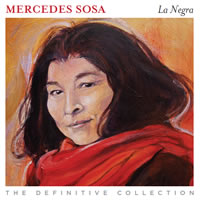La Negra - The Definitive Collection

- CD1: 1. Algarrobo Algarrobal
- CD1: 2. Al Jardin De La Republica
- CD1: 3. Luna Tucumana
- CD1: 4. Viva Jujuy
- CD1: 5. Cuando Tenga La Tierra
- CD1: 6. La Pobrecita
- CD1: 7. La Pomena
- CD1: 8. Arana (with Los Andariegos)
- CD1: 9. Si Se Calla El Cantor (with Horacio Guarany)
- CD1: 10. Siembra (with Kleiton Y Kledir)
- CD1: 11. Pedro Canoero (with Teresa Parodi)
- CD1: 12. El Tiempo, El Implacacable, El Que Paso (with Pablo Milanes)
- CD1: 13. Yo Vengo a Ofracer Mi Corazon (with Francis Cabrel)
- CD1: 14. El Alazan
- CD1: 15. Zambita De Los Pobres
- CD1: 16. Balderrama (with Santiago Bertiz)
- CD1: 17. Honrar La Vida (with Marlina Ross)
- CD1: 18. Todo Cambia
- CD1: 19. Peoncito De Estancia
- CD1: 20. Sueno Con Serpientes (With Milton Nascimento)
- CD2: 1. Solo le Pido A Dos (with Leon Gieco)
- CD2: 2. Cancion Con Todos
- CD2: 3. Anos (with Raimundo Fagner)
- CD2: 4. Parte Del Aire (with Fito Paez)
- CD2: 5. Alfonsina Y El Mar (with Ariel Ramirez)
- CD2: 6. Venas Abiertas (with Cuarteto Zugay)
- CD2: 7. Cristal
- CD2: 8. La Navidad De Juanito Laguna
- CD2: 9. Maria Va (with Antonio Tarrago Ros)
- CD2: 10. Cinco Siglos Igual (with Jamie Torres)
- CD2: 11. Zambia Para No Morir (Zamba)
- CD2: 12. Zamba A Monteros
- CD2: 13. Inconciente Colectivo (with Milton Nascimento & Charly Garcia)
- CD2: 14. Zamba Por Vos
- CD2: 15. La Villerita (Chamame)
- CD2: 16. Cuchillos (with Charly Garcia)
- CD2: 17. Agitando Panuelos (Zamba)
- CD2: 18. Aya Marcay Quilla (with Victor Heredia)
- CD2: 19. Del Tiempo De Mi Ninez
- CD2: 20. La Colina De LA Vida (with Nuno Mestre)
Mercedes Sosa’s popularity in Latin America spanned over half a century. She was dubbed “the voice of the silent majority” and was credited with championing the poor and fighting for political change, singing of political violence, the struggle for justice and her own pain of living in exile. Sosa acquired the nickname ‘La Negra’ because of her jet black hair.
Born on the 9th July 1935 in San Miguel de Tucumán, the capital of one of Argentina’s smallest provinces, into a working class family from mixed French and Amerindian (indigenous) ancestry, Haydee Mercedes Sosa started singing and folk dancing as a child. She sang with a contralto voice of extraordinary depth and beauty and played a bombo drum which was to become her trademark. She won a local radio competition aged 15, which allowed her to sing for the station for two months which enabled her to turn professional. However her first album was not recorded until nine years later, and a further six years after that, in 1965, it was her performance at the Cosquín National Folklore Festival that brought her true fame in her native land.
Despite initially being plagued by intense stage fright, Sosa became a founding member of the Nueva Cancion movement along with her first husband Manuel Oscar Matus. Although not noted as a songwriter herself, her interpretation of songs by icons such as fellow Argentine Atahualpa Yupanqui and Chile's Violeta Parra helped to popularise the movement, and in 1967 she took her music on a successful tour to USA and Europe.
Sosa’s political themes and activism started to cause her trouble when the Argentinian military, under Jorge Videla, staged a coup in March 1976. Initially only some of Sosa's songs were censored, but as she became seen internationally as a voice of freedom, the government harassment increased, her songs became more political hence more of her songs were banned. This came to a head when she was humiliatingly searched and arrested when she was on stage performing in a city called La Plata. The military not only arrested Sosa but also everyone else in the audience. She was detained for over 18 hours and finally released after international condemnation.
After this and a number of death threats, she decided to go into exile to Europe; first of all to Paris and then Madrid. She found a life in exile very difficult and in 1982, after a decade of living away from her beloved homeland, she returned just before the collapse of military rule. Although when she arrived the military junta were still in power, she was so well known both in her country and internationally that she was well received and excluded from any punishment.
The return to Argentina proved to be a triumph: Sosa performed a series of concerts at The Opera Teatro Colón in Buenos Aires with many of her younger musical colleagues and contemporaries, and the resulting recordings were huge sellers. She continued to tour internationally, selling out venues such as Carnegie Hall in New York, The Coliseum in Rome, and The Royal Festival Hall in London (1999). Though performances became rarer as her health deteriorated through the 1990s, there were several successful ‘comebacks’, notably in 1998 in Buenes Aires, with another series of big live shows, and again with new material in 2005. Mercedes Sosa died at the age of 74 in 2009. Such was her status in Argentina, on news of her death the President ordered three days of National Mourning and thousands queued for hours to pay homage to her at The National Congress in Buenos Aires.
In her extraordinary career, Sosa released 70 albums over six decades and achieved three Latin Grammy awards. Sosa was not only prolific but also recognised for her extraordinary versatility. Her work incorporated Argentinian tango, Cuban nueva trova, Brazilian bossa nova as well as rock influences, and she also performed and sang with many great South American artists, such as Pablo Milanes and Milton Nascimento, who both feature on tracks here - as well as many international artists including Luciano Pavarotti, Sting, Joan Baez and Shakira.






